| Published: | 2010-11-13 |
| Manufacturer: | Binder Design  |
![[Picture]](/images/archive/images/ratings/rating_bd_dragonfly.gif) (09/10/02) It is always
nice to see a little uniqueness in rocket designs and that is exactly what
Binder Designs' new (for 2002) Dragonfly has. Its fins, length and finish
recommendations are all to help it look like a Dragonfly. According to Binder,
the kit is "geared for the beginner to mid/high power". I
would agree, as it is a very straight-forward kit to build. But Binder also
says that you can "expect about 3,000 ft. on a G motor" so,
for those folks that like altitude, the Dragonfly will meet your needs
too.
(09/10/02) It is always
nice to see a little uniqueness in rocket designs and that is exactly what
Binder Designs' new (for 2002) Dragonfly has. Its fins, length and finish
recommendations are all to help it look like a Dragonfly. According to Binder,
the kit is "geared for the beginner to mid/high power". I
would agree, as it is a very straight-forward kit to build. But Binder also
says that you can "expect about 3,000 ft. on a G motor" so,
for those folks that like altitude, the Dragonfly will meet your needs
too.
I also did a comparison on Mid to High Power Starter Rockets - See Here.
The kit was packaged very well. In fact, it was absolutely the best packaged Mid/High Power kit that I have ever seen. I regret not taking a picture to share in this review. The pieces where all separated in single large plastic package. Very nice, indeed.
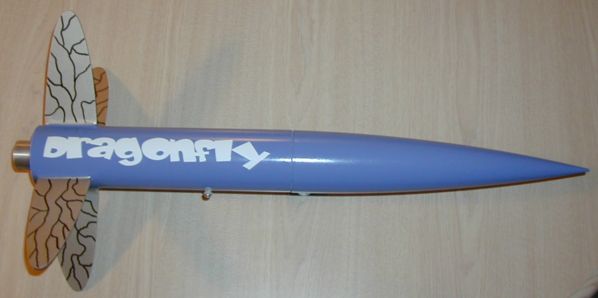
The Dragon fly is 24" tall which is made up of its 13" plastic nose cone and 11" of 2.6" body tube. The body tube is pre-slotted for the fins. The motor mount included (2) 1/8" thick composite centering rings (very smooth on one side and very rough on the other) and a 4½" length of 29mm motor tube. The recovery system is made up of and eye-bolt assembly, a quick-link, 12' of 3/16" tubular nylon (awesome) and an 18" Binder Design Premium Chute parachute meaning, it is 1.9 oz. diamond weave rip-stop balloon fabric. On one side it is coated for zero porosity and heat resistance. The fins are all pre-cut 1/8" plywood. The kit is completed with a 1/4" launch lug and a vinyl Dragonfly decal.
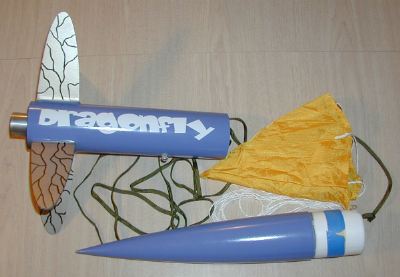 A couple of upgrades from Binder that were added to my kit
included a 29mm Motor Collar (retainer, a Binder Design product) and a
24mm adaptor.
A couple of upgrades from Binder that were added to my kit
included a 29mm Motor Collar (retainer, a Binder Design product) and a
24mm adaptor.
CONSTRUCTION:
The instructions are excellent. They include 9 pages of written and illustrated instructions and a page for the Fin Alignment Guide. The instructions would be able to walk even the less-experienced model rocketeer through successfully. They include finishing details including the decal and the special fin finishing technique. They also include flight preparation and spec data for CP and CG.
As stated above the kit build is straight-forward, so I will just hit on a few of the topics.
The motor mount is assembled. It went together well. I had to lightly sand the outside of the centering rings to get a clean fit into the body tube. The upper centering ring gets an 1/8" hole drilled into it for mounting the eye-bolt assembly. It is then glued to the motor tube. Instructions are clear, including an illustration to tie the knot for attaching the shock cord to the quick-link which is then hooked to the eye-bolt. The lower centering ring is not attached at this time but it is placed on the motor mount. The whole assemble is then glued into the rocket so that the motor tube is flush with the bottom. The lower centering ring is removed so that internal fillets can be applied.
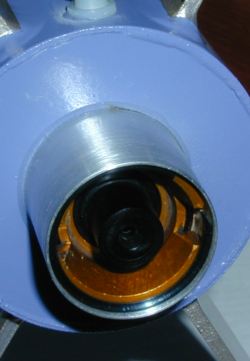 In
the case of using the Motor Collar upgrade, the motor tube is left sticking out
1/2" to allow you to attach the collar. The instructions point this out,
too.
In
the case of using the Motor Collar upgrade, the motor tube is left sticking out
1/2" to allow you to attach the collar. The instructions point this out,
too.
After the fins are beveled (which I did not do) they are attached to the rocket. The fins are through-the-wall and attach to the 29mm motor tube. Then the instructions describe making internal fillets. This technique really makes the fin mounts strong!
I used Fix-It Epoxy Putty sold by Apogee Components for the outter fillets. I really like this stuff and am pleased with the fillets that you can make with it.
After this, the instructions have you attach the launch lug. I skipped this step and later added rail buttons.
One other comment about the kit: the nose cone was really loose in the body tube. It took several wraps of tape before it was tight enough to fly.
That's it. Now it is time to finish the rocket.
Binder gives good instructions for finishing the rocket, but I stuck with my own techniques. I used my standard method for finishing Kraft paper tubes and also for finishing plastic nose cones. I painted the whole rocket a lighter Krylon purple paint to mimic a color of a Dragonfly that my wife has a picture of in our bathroon. I painted the wings, I mean fins, a platinum color. I then used a permanent black Sharpie to put the wing veins on. This was described in the instructions. I also tried to mimic the picture in our bathroom by drawing three body segments with the marker. Probably not the best idea since I'm not much of a artist. Lastly, I applied the vinyl decals. I love vinyl decals! I finished the whole rocket using Krylon Clear over everything.
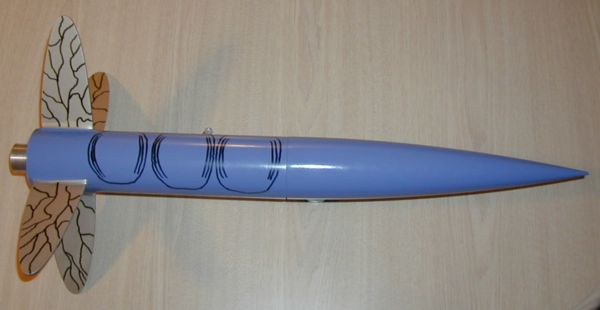
Overall, for CONSTRUCTION I would rate this kit 4 ½ points. The quality of the components, packing of the them, illustrated instructions, and vinyl decals make this a complete package. The nose cone was really loose. Also the standard kit does not come with motor retention, but if you add the upgrade of the Motor Collar there is nothing to complain about.
 FLIGHT/RECOVERY:
FLIGHT/RECOVERY:
The only motor recommendations were written into the instructions this way: "We recommend an F motor or a mid thrust G motor for your first flight". The RockSim file that Binder has placed on our site show simulations for everything from a D12-3 to an H238!
That same RockSim file (and the drawing with specs included in the instructions) show the weight to be 8.4 ounces with a CG at 15.4" from the nose cone. My actual Dragonfly weighed exactly 12 ounces and the CG was at 17.3". Why? Most likely due to moving the motor mount back 1/2" and adding the Motor Collar. In addition the epoxy fillets add weight not accounted for in Binder's RockSim. I also added a Pratt Heat Shield to protect my parachute.
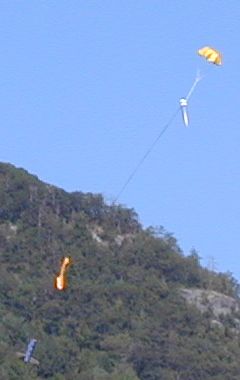 The first launch of this rocket was on a 29mm RMS E16-4. This was
a very old motor and it took us two attempts with home-dipped ignitors to get
it off the pad. But, once off the pad it gave a very nice flight. RockSim
simulated to about 670 feet. I believe it. The ejection popped just after it
had turned at apogee and started to head down. The parachute size brought the
rocket down at a good rate. Very nice first flight!
The first launch of this rocket was on a 29mm RMS E16-4. This was
a very old motor and it took us two attempts with home-dipped ignitors to get
it off the pad. But, once off the pad it gave a very nice flight. RockSim
simulated to about 670 feet. I believe it. The ejection popped just after it
had turned at apogee and started to head down. The parachute size brought the
rocket down at a good rate. Very nice first flight!
For FLIGHT/RECOVERY, I would rate this kit 5 points. Even though I only have one flight I will go ahead and rate this rocket. If anything changes with future flights I will update this file. The rocket flew straight and stable. The recovery system is sized right. The recovery materials are excellent too. The kit does not come with a 24mm adaptor, however, it can be purchased as an upgrade. This will allow some flight versatility with E30's, E28's, E18's, F24's and F39's. My next launch is planned in November with this bird experiencing a G125-10 - yippee! This motor should take this rocket to 2500 feet.
I give the kit an OVERALL rating of 5 points. Excellent instructions, materials and eay to build. Vinyl decals. Unique fins. Under 16 ounces. And the list could go on. If you are just venturing into mid to high-power, give this rocket a look!
Other Reviews
- Binder Design Dragonfly By Michael Verbeek
Picture Courtesy of Binder Designs Single stage with four fins placed not at 90 degrees to each other - to mimic a dragon fly. The kit consisted of (1) paper body tube slotted for fin placement, a nose cone, plywood centering rings and pre-cut plywood fins (fins are mounted to the motor mount), a 29mm paper tube motor mount, a fin alignment guide, the Dragonfly decals and CP, CG ...
 |
 |
Flights
 |
 |
M.E.R. (July 12, 2009)
 |
 |
L.A. (August 16, 2003)